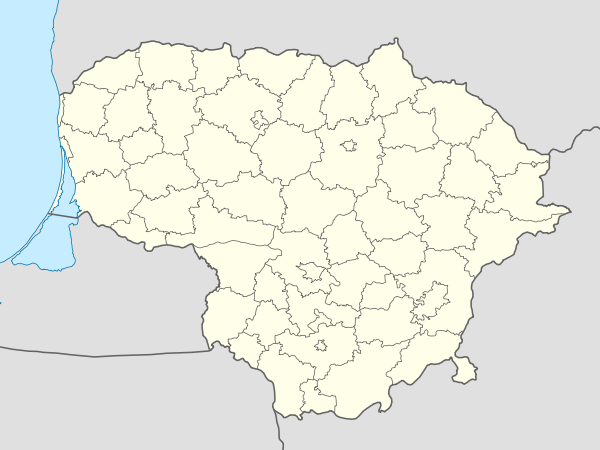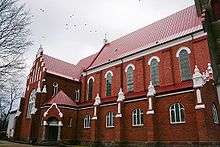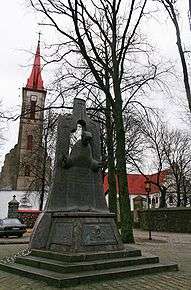Kretinga
| Kretinga | ||
|---|---|---|
| City | ||
|
Kretinga city square | ||
| ||
 Kretinga Location of Kretinga | ||
| Coordinates: 55°53′24″N 21°14′32″E / 55.89000°N 21.24222°ECoordinates: 55°53′24″N 21°14′32″E / 55.89000°N 21.24222°E | ||
| Country |
| |
| Ethnographic region | Samogitia | |
| County |
| |
| Municipality | Kretinga district municipality | |
| Eldership | Kretinga town eldership | |
| Capital of |
Kretinga district municipality Kretinga town eldership Kretinga rural eldership | |
| First mentioned | 1253 | |
| Granted city rights | 1607 | |
| Population (2015) | ||
| • Total | 18,732 (18th) | |
| Time zone | EET (UTC+2) | |
| • Summer (DST) | EEST (UTC+3) | |
Kretinga (![]() pronunciation , German: Krottingen) is a city in Klaipėda County, Lithuania. It is the capital of the Kretinga district municipality. It is located 12 km (7.5 mi) east of the popular Baltic Sea resort town of Palanga, and about 25 km (16 mi) north of Lithuania's 3rd largest city and principal seaport, Klaipėda.
pronunciation , German: Krottingen) is a city in Klaipėda County, Lithuania. It is the capital of the Kretinga district municipality. It is located 12 km (7.5 mi) east of the popular Baltic Sea resort town of Palanga, and about 25 km (16 mi) north of Lithuania's 3rd largest city and principal seaport, Klaipėda.
The population was listed as 21,421 in the 2006 census. It is the 6th largest city in the ethnographic region of Samogitia and the 17th largest city in Lithuania.
History


Kretinga is one of the oldest known cities in Lithuania. It was first mentioned in 1253 as castle Cretyn under the charter of Bishop Heinrich of Courland.[1]
In 1602 Jan Karol Chodkiewicz built the first wooden church in Kretinga and established a Benedictine monastery, which became a great success. After about ten years a new brick church with an impressive organ was built. In 1610 a church school was opened.
In 1609 Jan Karol Chodkiewicz announced that he would establish a new city next to the old village and would grant the new city Magdeburg rights. The new city adopted a coat of arms depicting the Blessed Virgin Mary with the baby Jesus in her arms. Kretinga's patron saint remains the Blessed Virgin.[2]
In 1621 the Sapieha family gained control of the city; they changed its coat of arms to represent Saint Casimir. In 1659 and 1710 the church and monastery were destroyed by Swedish armies. The Sapieha family helped to rebuild and improve it.
In 1720 the city came under the jurisdiction of the Massalski family. Ignacy Jakub Massalski opened a university preparatory school in 1774. The city lost its municipal rights after the partitions of the Polish–Lithuanian Commonwealth.
The city prospered during the 19th century as part of the Russian Empire. In 1882 the first telephone line in Lithuania connected Kretinga with Plungė and Rietavas. In 1875, Count Tiškevičius decided to establish his family estate in Kretinga; he purchased and rebuilt an old palace. Following the fashions of the Victorian era, the family landscaped it lavishly and built a greenhouse featuring exotic flowering plants and tropical fruits. In 1890 they installed electricity in the manor.

During World War I, the Germans built a railroad connecting Bajorai,[3] Kretinga, and the Latvian city of Priekule. In 1924 Kretinga regained its municipal rights. During the interwar period, the village of Kretingsodis, on the other side of the Akmena River, was incorporated into the city. Kretinga gained greater importance after another railroad was built in 1932 that connected it to Šiauliai.
During the first Soviet occupation, under the Molotov-Ribbentrop Pact, a reign of terror resulted in local residents being arrested and, in some cases, executed without trial or deported to Siberia. A local lawyer, Vladas Petronaitis, was arrested and ultimately tortured to death by the Soviet intelligence agency.
The World War II Nazi occupation saw the elimination of Kretinga's Jewish population as they were faced with death or deportation. As in neighbouring Palanga local Lithuanian nationalists volunteered to assist in the killing of Jewish citizens as soon as the German army and police units had arrived. The Soviet occupation in 1945 led to further reductions in the population as refugees fled to the west and many of those trapped were deported to Siberia.
The local economy stagnated under Soviet occupation, which forcibly collectivized the farms in the area; it became an economic backwater.
Since Lithuania's independence in 1990, the town has made a recovery - it has much to offer by way of history and art. Kretinga hosts folk music festivals, theatricals, the Kretinga Festival, celebrations on Midsummer Night's Eve (Joninės) and Mardi Gras (Užgavėnės), and a Manorial Feast. The manor is now a museum housing artistic and archeological collections and a restaurant in the adjacent greenhouse, called "The Winter Garden". A Cambrian geothermal reservoir underlies the area, and the Vydmantai powerplant exploiting this resource is being built nearby.[4]
Its Kretinga Jurgis Pabrėža gymnasium was founded in 1980.
Notable people
- Simonas Daukantas, author of the first history of Lithuania written in Lithuanian, briefly studied in Kretinga
- Jurgis Pabrėža, first Lithuanian botanist; died and buried in Kretinga
- Vladas Petronaitis, recipient of the Lithuanian Independence Medal; he was executed during the first Soviet occupation
- Linas Pilibaitis, Lithuanian international footballer, was born in Kretinga.
- Aaron of Pinsk, rabbi in Kretinga and afterward in Pinsk
- Rimvydas Šilbajoris,[5] linguist, author, and professor at Ohio State University
- Adolfas Večerskis, actor
References
- ↑ "Herder-Institut: 404". Herder-institut.de. Retrieved 2013-09-22.
- ↑ Archived March 17, 2006, at the Wayback Machine.
- ↑ "Bajorai, Liuthuania Page". Fallingrain.com. Retrieved 2013-09-22.
- ↑ Archived August 11, 2006, at the Wayback Machine.
- ↑ "LISTSERV 16.0". Listserv.linguistlist.org. Retrieved 2013-09-22.
External links
| Wikimedia Commons has media related to Kretinga. |
- (English) Kretinga's official website
- (English) Historic images of Kretinga
- (English) The Kretinga Manor Museum
- (English) Geothermal resources in Lithuania
- (Lithuanian) Benedictine monastery
- (Lithuanian) History of Kretinga
- (Lithuanian) Encyclopedia of Kretinga
- (Lithuanian) News, information and events website of Kretinga

